
NGS has revolutionized our ability to uncover a vast array of genetic information with unprecedented depth and breadth. As a complementary technology, digital PCR (dPCR) is a powerful tool to enable further verification of selected biomarkers in routine molecular testing and longitudinal monitoring (1).
Here you'll find a general overview and comparison of NGS and dPCR technologies.
How dPCR complements NGS
Complementary roles to advance personalized medicine
As the landscape of molecular testing continues to evolve, the complementary roles of NGS and dPCR will become increasingly central to advancing research into personalized medicine approaches. By leveraging the strengths of each technology, clinicians and translational researchers can navigate the complexities of the genome with greater accuracy, efficiency and cost-effectiveness. Combining the broad capabilities of NGS with the targeted precision of dPCR will enable a better understanding of the genetic factors driving disease and enhance precision medicine.
Applications for dPCR downstream of NGS
Monitoring biomarkers using dPCR
dPCR has shown its value in molecular testing across oncology, infectious diseases and genetic disorders. Once a broad set of gene mutations has been tested using NGS, dPCR is a valuable method for longitudinal monitoring and quantification of biomarkers.
Its high precision, sensitivity and capacity for absolute quantification of DNA or RNA enables labs to monitor minute genetic changes, which may play a crucial role in the ongoing management of diseases.
Treatment response monitoring
dPCR transforms how researchers follow patient treatment responses by providing highly precise and sensitive measurements for monitoring biomarkersWhy use dPCR versus qPCR for monitoring biomarkers?
Use case
What's the clinical value of monitoring biomarkers in patients?
Monitoring biomarkers in Tim's tumor will contribute to the evaluation of his treatment response. It will also potentially identify early signs of molecular relapse. To achieve this, dPCR could be installed at a lab of any size, whether small or medium-sized, as well as a large testing lab, and would be an adequate and appropriate monitoring solution to co-position with diagnostic NGS in the patient journey.
In this scenario, Tim will be retested regularly per the current recommendations (ideally every 3 months) for EGFR L858R, using liquid biopsy samples to establish treatment response and continuous reevaluation of response and/or early signs of relapse. If a potential relapse is detected, Tim's new liquid biopsy sample could be sent for a larger comprehensive NGS panel screen at a centralized testing lab to establish whether there are additional molecular indicators of therapy resistance.
The ‘centralized and community lab' model
In the ‘centralized and community lab' model, the 'centralized lab' is typically a larger laboratory equipped with advanced NGS technology and specialized personnel. It serves as the core facility for extensive complex genetic sequencing. Surrounding the centralized lab are the 'community labs', which consist of smaller, local laboratories or healthcare facilities. These labs collect samples and handle preliminary processing before sending them to the centralized lab for detailed analysis. After analysis, the results are returned to the smaller community lab, where local clinicians validate their findings before applying them to patient care.
Example scenario of a single patient's solid tumor testing journey
Featured products
QIAcuityDx is intended for in vitro diagnostic use. Product availability may vary by country specific regulatory requirements and approvals. Contact your country representative or visit www.qiagen.com for further details.
QIAcuity Digital PCR instruments are sold under license from Bio-Rad Laboratories, Inc. and exclude rights for use with pediatric applications.
For up-to-date licensing information and product-specific disclaimers, see the respective QIAGEN kit instructions for use or user manual. QIAGEN instructions for use and user manuals are available at www.qiagen.com or can be requested from QIAGEN Technical Services.
References:
- Yuan P, Cao J, He X, Sui J, Si L, Wang Q, Li Y, Wang Y, Jiang Z. The diagnostic accuracy of digital PCR, ARMS and NGS for detecting KRAS mutation in cell-free DNA of patients with colorectal cancer: A systematic review and meta-analysis. PLoS One. 2021;16(3):e0248775.
- Scimone C, Pepe F, Russo G, Palumbo L, Ball G, Morel P, Russo A, Troncone G, Malapelle U. Technical evaluation of a novel digital PCR platform for detecting EGFR/KRAS mutations in NSCLC archived plasma specimens. J Liquid Biopsy. 2024;3:100133.
- Drandi D, Genuardi E, Dogliotti I, Ferrante M, Jiménez C, Guerrini F, Schirico ML, Mantoan B, Muccio V, Lia G, Zaccaria GM, Omedè P, Passera R, Orsucci L, Benevolo G, Cavallo F, Galimberti S, Sanz RG, Boccadoro M, Ladetto M, Ferrero S. Highly sensitive MYD88L265P mutation detection by droplet digital polymerase chain reaction in Waldenström macroglobulinemia. Haematologica. 2018;103(6):1029.
- Galimberti S, Balducci S, Guerrini F, Del Re M, Cacciola R. Digital droplet PCR in hematologic malignancies: A new useful molecular tool. Diagnostics. 2022; 12(6):1305.
- Quan PL, Sauzade M, Brouzes E. dPCR: A technology review. Sensors (Basel). 2018;18(4):1271.
- Coccaro N, Tota G, Anelli L, Zagaria A, Specchia G, Albano F. Digital PCR: A reliable tool for analyzing and monitoring hematologic malignancies. Int J Mol Sci. 2020;21(9):3141.
- Mosele F, Remon J, Mateo J, Westphalen CB, Barlesi F, Lolkema MP, Normanno N, Scarpa A, Robson M, Meric-Bernstam F, Wagle N, Stenzinger A, Bonastre J, Bayle A, Michiels S, Bièche I, Rouleau E, Jezdic S, Douillard JY, Reis-Filho JS, Dienstmann R, André F. Recommendations for the use of next-generation sequencing (NGS) for patients with metastatic cancers: a report from the ESMO Precision Medicine Working Group. Ann Oncol. 2020; 31(11):1491.


